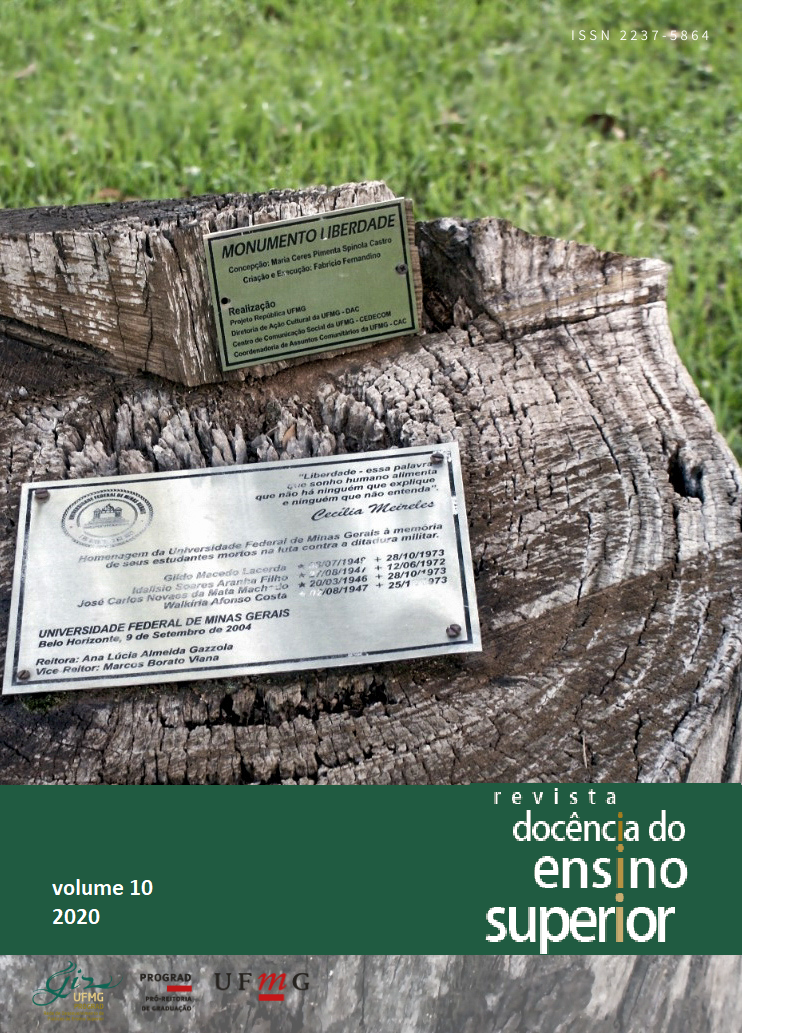Team Based Learning method in the teaching and learning of applied Inorganic Chemistry
a socio-interactional view
DOI:
https://doi.org/10.35699/2237-5864.2020.15216Keywords:
Collaborative learning, Active methodology, Zone of proximal development, Rare earths, Chemistry teachingAbstract
In this work, the Team-Based Learning (TBL) method was used for the application of a mini-course on luminophores based on rare earths, given to new students in the Chemistry Degree course at FCT/UNESP. At TBL, students' development is promoted through group work and the improvement of their own individualities. This method is lined up with Vygotsky's theoretical framework, which establishes a narrowing between language and thought, and a threshold between what an individual is capable of doing alone and what it is capable of doing with external assistance, called the Zone of Proximal Development, ZPD. Such concepts were considered during the mini-course, generating data that was collected in the form of questionnaires and audio recordings. The results indicated that the collective work stands out over the individual one. These conclusions agree with what was proposed by the adopted method and also with the theoretical framework, that is, group work promotes improvements in student learning.
Downloads
References
ATKINS, Peter William; JONES, Loretta. Princípios de química: questionando a vida moderna e o meio ambiente. 5. ed. Porto Alegre: Bookman, 2012.
BÜNZLI, Jean-Claude Georges. Lanthanide Luminescence for Biomedical Analyses and Imaging. Chemical Review, Washington, v. 110, n. 5, p. 2729-2755, nov./dez. 2010. DOI: https://doi.org/10.1021/cr900362e.
CHAIKLIN, Seth. The zone of proximal development in Vygotsky’s analysis of learning and instruction. In: KOZULIN, A. et al. (org.). Vygotsky’s educational theory in cultural context. Cambridge: Cambridge University Press, 2003.
COELHO, Luana; PISONI, Silene. Vygotsky: sua teoria e a influência na educação. Revista e-Ped – FACOS/CNEC Osório, Osório/RS, v. 2, n. 1, p. 144-152, ago. 2012.
CONNELLY, Neil G. et al. IUPAC Nomenclature of Inorganic Chemistry, Recommendations 2005. Cambridge: RSC Publishing, 2005.
DIBIANCA, Frank A. et al. General Electric Company: rare earth ceramic scintillator. United States, patent US 4525628. Jun. 25, 1985.
FINO, Carlos Nogueira. Vygotsky e a Zona de Desenvolvimento Proximal (ZDP): três implicações pedagógicas. Revista Portuguesa de Educação, Braga, v. 14, n. 2, p. 273-291, 2001.
KRUG, Rodrigo de Rosso et al. O “Bê-Á-Bá” da Aprendizagem Baseada em Equipe. Revista Brasileira de Educação Médica, Porto Alegre, v. 40, n. 4, p. 602-610, fev. 2016. DOI: http://dx.doi.org/10.1590/1981-52712015v40n4e00452015.
MICHAELSEN, Larry K. Getting Started with Team-Based Learning. In: MICHAELSEN, Larry K.; KNIGHT, Arletta Bauman; FINK, L. Dee. Team-Based Learning: a transformative use of small groups in college teaching. Sterling, VA: Stylus Publishing, LLC, 2004. p. 2750.
OLIVEIRA, Tobias Espinosa de; ARAUJO, Ives Solano; VEIT, Eliane Angela. Aprendizagem Baseada em Equipes (Team-Based Learning): um método ativo para o Ensino de Física. Caderno Brasileiro de Ensino de Física, Porto Alegre, v. 33, n. 3, p. 962-986, dez. 2016. DOI: https://doi.org/10.5007/2175-7941.2016v33n3p962.
RONDA, Cees. Luminescence: From Theory to Applications. Weinheim: WILEY-VCH Verlag GmbH & Co. KGaA, 2008.
SÁ, Luciana Passos; FRANCISCO, Cristiane Andretta; QUEIROZ, Salete Linhares. Estudos de caso em Química. Química Nova, São Paulo, v. 30, n. 3, p. 731-739, mar. 2007. DOI: http://dx.doi.org/10.1590/S0100-40422007000300039.
SANTOS, Anderson Oliveira et al. Dificuldades e motivações de aprendizagem em Química de alunos do ensino médio investigadas em ações do (PIBID/UFS/Química). Scientia Plena, São Paulo, v. 9, n. 7, p. 1-7, mar. 2013.
SOUSA FILHO, Paulo César de; LIMA, Juliana Ferreira; SERRA, Osvaldo Antônio. From Lighting to Photoprotection: fundamentals and applications of rare earth materials. Journal of the Brazilian Chemical Society, São Paulo, v. 26, n. 12, p. 2471-2495, 2015. DOI: http://dx.doi.org/10.5935/0103-5053.20150328.
SOUSA FILHO, Paulo César de; SERRA, Osvaldo Antônio. Terras raras no Brasil: histórico, produção e perspectivas. Química Nova, São Paulo, v. 37, n. 4, p. 753-760, jan. 2014. DOI: http://dx.doi.org/10.5935/0100-4042.20140121.
TEIXEIRA JÚNIOR, José Gonçalves; SILVA, Rejane Maria Ghisolfi da. Perfil de leitores em um curso de Licenciatura em Química. Química Nova, São Paulo, v. 30, n. 5, p. 1365-1368, abr. 2007. DOI: http://dx.doi.org/10.1590/S0100-40422007000500052.
TILLEY, Richard J. D. Colour and the Optical Properties of Materials. 2. ed. United Kingdom: John Wiley & Sons, Ltd., 2011.
VYGOTSKY, Lev Semyonovich. Mind in Society: the development of higher psychological processes. Cambridge, MA: Harvard University Press, 1978.
VYGOTSKY, Lev Semyonovich. Thought and Language. The MIT Press, 1986.
ZUCCO, Cesar; PESSINE, Francisco Benedito Teixeira; ANDRADE, Jailson Bittencourt de. Diretrizes Curriculares para os Cursos de Química. Química Nova, São Paulo, v. 22, n. 3, p. 454-461, abr. 1999. DOI: http://dx.doi.org/10.1590/S0100-40421999000300027.
Downloads
Published
Issue
Section
License
Authors who publish in this journal retain the copyright and grant the journal the right of first publication, with the work simultaneously licensed under the Creative Commons Attribution License which allows the sharing of work with acknowledgment of authorship and initial publication in this journal.
Authors are authorized to take additional contracts separately, for non-exclusive distribution of the version of the work published in this journal (e.g. publish in institutional repository or as a book chapter), with acknowledgment of authorship and initial publication in this journal.
Open access policy:
Revista Docência do Ensino Superior is an Open Access journal, which means that all content is available free of charge, at no cost to the user or their institution. Users may read, download, copy, distribute, print, search, or link to the full texts of the articles, or use them for any other legal purpose, without seeking prior permission from the publisher or author, provided they respect the license to use the Creative Commons used by the journal. This definition of open access is in line with the Budapest Open Access Initiative (BOAI).



























